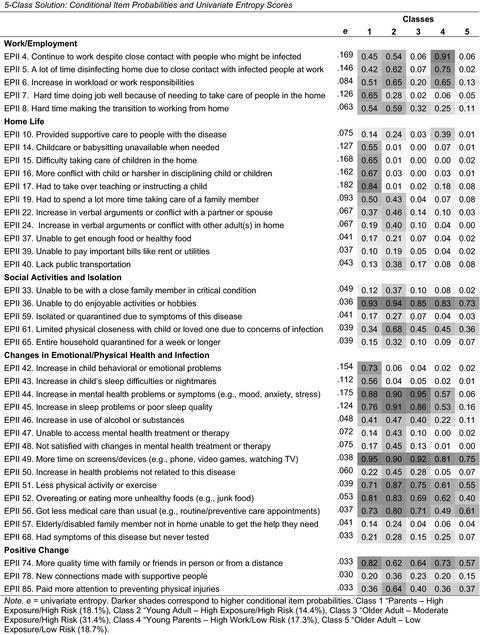Profiling COVID-related experiences in the United States with the Epidemic-Pandemic Impacts Inventory: Linkages to psychosocial functioning PEER REVIEW DATA AVAILABILITY STATEMENT
04/12/2021 By RuneLite
1 INTRODUCTION
In the first three-month period, the COVID-19 pandemic has had a profound impact on individuals, families, and communities across the world. Intensive health precautions have created constraints on mobility (e.g., sheltering in place, self-quarantining), work and schooling (e.g., virtual commuting, homeschooling), family life (e.g., more intensive contact in primary household relationships, separation from extra-household family members), and interpersonal relationships (e.g., social distancing, wearing masks). A number of survey studies have found evidence of an increase in self-reported emotional and behavioral problems (e.g., anxiety, depression, stress disorders, insomnia) in the pandemic's immediate wake (Breslau et al.,
2021
; Fu et al.,
2021
; García-Fernández et al.,
2020
; Murata et al.,
2021
; Petzold et al.,
2020
; Wu et al.,
2020
). However, few studies have examined the impact of specific pandemic-related experiences or patterns of experiences, both negative and positive, on functioning, which is necessary for understanding the origins of burden on families toward developing public health interventions. Some exceptions include a study associating limitations in mobility with higher psychosocial distress in a United States sample (Devaraj & Patel,
2021
) and an international study associating COVID exposure, government-imposed quarantine level, and lifestyle changes with increased reports of depression and anxiety (Alzueta et al.,
2021
), as well as increases in domestic conflict with self-reported sleep difficulties (Yuksel et al.,
2021
).
The goal of the present study was to employ a person-centered analytic approach for empirically identifying specific profiles of pandemic-related experiences and their relation to psychosocial functioning with information from the novel Epidemic-Pandemic Impacts Inventory (EPII; Grasso et al.,
2020
). The EPII is a comprehensive, 92-item inventory of experiences that extend across five thematic domains including adverse experiences specific to work/employment, home life, social activities and quarantine, and emotional/physical health and infection, as well as positive changes. The EPII is currently maintained in the National Institute of Health (NIH) Disaster Research Response (DR2) Repository of COVID-19 Research Tools (https://dr2.nlm.nih.gov). Recent studies using the EPII have associated specific pandemic-related experiences with increased risk for depression and anxiety (Alzueta et al.,
2021
; Yuksel et al.,
2021

), cumulative counts of adverse experiences with psychosocial distress and coping difficulties among teachers (Baker et al.,
2021
), and positive experiences with better psychosocial health in Scottish adults (Williams et al.,
2021
).
The present study sought to determine whether patterns of co-occurring pandemic-related experiences on the EPII define unique profiles of individuals that also differ on sociodemographic characteristics and psychosocial functioning. Profiles were empirically determined using latent class analysis (LCA), an exploratory, person-centered, data-driven approach for clustering individuals on a set of characteristics. LCA was applied to a subset of EPII items showing a significant correlation with a separate measure of perceived stress. Demonstrating unique profiles of pandemic-related experiences that differentially predict psychosocial risk would support the construct validity of the EPII. Notably, traditional factor analytic methods grounded in classical test theory are not appropriate for evaluating the validity of instruments that inventory event-type data (Felix et al.,
2019
), as is the case for the EPII. Classical methods treat items as indicators of latent constructs and assume an underlying, normally distributed latent variable or variables comprised of correlated indicators. LCA is not bound by these assumptions and provides the means to identify items or experiences that probabilistically co-occur to characterize unique profiles or subgroups of individuals.
LCA also provides information beyond what is possible by summing event-type data to create a cumulative count of experiences that may associate with risk. While this cumulative count approach is practical and statistically robust in predicting outcomes, drawbacks include erroneous assumptions that: (a) all items are equally associated with a particular outcome, (b) distances between sum scores are proportionately associated with an outcome, and (c) equivalent sum scores representing different combinations of items convey the same risk on an outcome (Netland,
2001
). As such, the cumulative count approach, while informative, offers little to be learned about risk specific to individual exposures or unique constellations of co-occurring exposures on outcomes.
In contrast, LCA uses maximum likelihood methods to empirically classify individuals into profiles or classes based on probabilistic patterns of co-occurring exposures. LCA is not bound to linear assumptions and can be used to test the significance of different combinations of exposures on outcomes. The trauma exposure field has seen a burgeoning of studies using LCA to identify unique subgroups of individuals with different combinations of trauma exposures (Dierkhising et al.,
2019
; Ford et al.,
2013
; Goldstein et al.,
2020
; Grasso et al.,
2013
; Grasso, Dierkhising, et al.,
2016
; Grasso, Petitclerc, et al.,
2016
). Additionally, to our knowledge, only one study has applied LCA to disaster-specific experiences to examine the impact of flooding on families (Felix et al.,
2019
). The latter study identified four unique profiles that were differentially associated with depression, anxiety, and PTSD symptoms.
To this end, the current study applied LCA to stress-related pandemic experiences assessed with the EPII in a cross-sectional survey conducted in the Northeast region of the U.S, the location of the initial epicenter of the pandemic in the U.S. The first aim was to use exploratory, person-centered LCA to examine whether unique profiles of individuals could be identified based on different patterns of probabilistically co-occurring stress-related pandemic experiences endorsed on the EPII. A second aim examined whether identified profiles of individuals would significantly differ on sociodemographic characteristics and psychosocial indicators. Identifying unique profiles of individuals with distinct patterns of pandemic-related experiences that differentially associate with psychosocial risk would support the validity of the EPII as an inventory of experiences relevant to understanding the impact of the pandemic on daily life, health, and well-being. The availability and efficient and validated measure of the specific impacts of mass disasters is critical for both current and future prevention and intervention efforts.